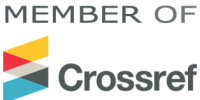Market Risk Prediction in the Oil Market Using Artificial Intelligence Approaches
Keywords:
risk prediction, oil market, artificial intelligence, machine learning, Random Forest, GARCH, volatility, Value at Risk (VaR), oil market fluctuationsAbstract
The oil market, due to its extensive economic impact and high price volatility, has always posed significant challenges for risk prediction and management. In this study, advanced artificial intelligence models, particularly machine learning, were employed to achieve more accurate predictions of oil market risk and their performance was compared with traditional models such as GARCH. The research findings indicated that machine learning models—especially the Random Forest algorithm—demonstrate greater accuracy and stability in predicting oil price fluctuations and assessing associated risks. These models can simulate nonlinear complexities and capture the effects of various economic and financial factors, such as stock market turbulence, unemployment indices, and interest rates, on oil market risk. Moreover, the results revealed that negative shocks exert a stronger influence on oil market volatility, and artificial intelligence models can effectively predict these impacts. This study particularly confirms the importance of using artificial intelligence models to forecast both short-term and long-term oil market risks and provides economic decision-makers with innovative tools to manage market risk effectively.
References
Abdulrahman, G. O. (2011). Concept of risk and risk management. International Journal of Students' Research, 1(2), 38-40. https://doi.org/10.5549/IJSR.1.2.38-40
Akash, T. R., Reza, J., & Alam, M. A. (2024). Evaluating financial risk management in corporation financial security systems. World Journal of Advanced Research and Reviews, 23(1), 2203-2213. https://doi.org/10.30574/wjarr.2024.23.1.2206
Alles, L. A. (1995). Investment risk concepts and measurement of risk in asset returns. Managerial Finance, 21(1), 15-25. https://doi.org/10.1108/eb018494
Alshabandar, R., Jaddoa, A., & Hussain, A. (2023). A risk model for assessing exposure factors influence oil price fluctuations. International Conference on Intelligent Computing,
Amin-Naseri, M. R., & Gharacheh, E. A. (2007). A hybrid artificial intelligence approach to monthly forecasting of crude oil price time series. The Proceedings of the 10th International Conference on Engineering Applications of Neural Networks,
An, J., Mikhaylov, A., & Moiseev, N. (2019). Oil price predictors: Machine learning approach. International Journal of Energy Economics and Policy, 9(5), 1-6. https://doi.org/10.32479/ijeep.7597
Aung, Z., Mikhaylov, I. S., & Aung, Y. T. (2020). Artificial intelligence methods application in oil industry. 2020 IEEE Conference of Russian Young Researchers in Electrical and Electronic Engineering (EIConRus),
Dimitriadou, A., Gogas, P., Papadimitriou, T., & Plakandaras, V. (2018). Oil market efficiency under a machine learning perspective. Forecasting, 1(1), 157-168. https://doi.org/10.3390/forecast1010011
Fallah, M. F., Pourmansouri, R., & Ahmadpour, B. (2024). Presenting a new deep learning-based method with the incorporation of error effects to predict certain cryptocurrencies. International Review of Financial Analysis, 95, 103466. https://doi.org/10.1016/j.irfa.2024.103466
Ghaffari, A. (2013). Concepts of Risk in Construction Projects. Advanced Materials Research, 684, 644-649. https://doi.org/10.4028/www.scientific.net/AMR.684.644
Gładysz, B., & Kuchta, D. (2022). Sustainable metrics in project financial risk management. Sustainability, 14(21), 14247. https://doi.org/10.3390/su142114247
Guan, L., Zhang, W. W., Ahmad, F., & Naqvi, B. (2021). The volatility of natural resource prices and its impact on the economic growth for natural resource-dependent economies: a comparison of oil and gold dependent economies. Resources Policy, 72, 102125. https://doi.org/10.1016/j.resourpol.2021.102125
Guo, Y., Zhang, S., & Liu, Y. (2022). Research on risk features and prediction of China's crude oil futures market based on machine learning. Frontiers in Energy Research, 10, 741018. https://doi.org/10.3389/fenrg.2022.741018
Jahanshahi, H., Uzun, S., Kaçar, S., Yao, Q., & Alassafi, M. O. (2022). Artificial intelligence-based prediction of crude oil prices using multiple features under the effect of Russia-Ukraine war and COVID-19 pandemic. Mathematics, 10(22), 4361. https://doi.org/10.3390/math10224361
Jumbe, G. (2022). Financial Market Risk Assessment Models: A Review Paper.
Kaznacheev, P. F., Regina, V. S., & Nikola, V. K. (2016). Improving Efficiency of the Oil and Gas Sector and Other Extractive Industries by Applying Methods of Artificial Intelligence. Ekonomicheskaya Politika/Economic Policy, 5, 188-197. https://doi.org/10.18288/1994-5124-2016-5-09
Kungwani, P. (2014). Risk management-an analytical study. IOSR Journal of Business and Management, 16(3), 83-89. https://doi.org/10.9790/487X-16338389
Lean, H. H., McAleer, M., & Wong, W. K. (2010). Market efficiency of oil spot and futures: A mean-variance and stochastic dominance approach. Energy Economics, 32(5), 979-986. https://doi.org/10.1016/j.eneco.2010.05.001
Li, X., Wei, Y., Chen, X., Ma, F., Liang, C., & Chen, W. (2022). Which uncertainty is powerful to forecast crude oil market volatility? New evidence. International Journal of Finance & Economics, 27(4), 4279-4297. https://doi.org/10.1002/ijfe.2371
Mehrara, M., & Hamldar, M. (2014). The relationship between spot and futures prices in Brent oil crude market. International Letters of Social and Humanistic Sciences, 39, 15-19. https://doi.org/10.18052/www.scipress.com/ILSHS.39.15
Mitra, S., & Ji, T. (2010). Risk measures in quantitative finance. International Journal of Business Continuity and Risk Management, 1(2), 125-135. https://doi.org/10.1504/IJBCRM.2010.033634
Mohamed, N. A., & Messaadia, M. (2023). Artificial intelligence techniques for the forecasting of crude oil price: a literature review. 2023 International Conference On Cyber Management And Engineering (CyMaEn),
Nicolau, M. (2012). Do spot prices move towards futures prices? A study on crude oil market. Acta Universitatis Danubius. Œconomica, 8(5), 166-175. https://www.ceeol.com/search/article-detail?id=560808
Nwulu, N. I. (2017). A decision trees approach to oil price prediction. 2017 International Artificial Intelligence and Data Processing Symposium (IDAP),
Qian, L., Zeng, Q., & Li, T. (2022). Geopolitical risk and oil price volatility: Evidence from Markov-switching model. International Review of Economics & Finance, 81, 29-38. https://doi.org/10.1016/j.iref.2022.05.002
Qin, J., Chen, C., Zhang, J., Liu, C., & Zhang, M. (2023). Investment Risk Analysis and Evaluation of Petroleum Exploration and Development Based on Artificial Intelligence. Proceedings of the 2023 International Conference on Power, Communication, Computing and Networking Technologies,
Rachev, S. T., Stoyanov, S. V., & Fabozzi, F. J. (2011). A probability metrics approach to financial risk measures. John Wiley & Sons. https://doi.org/10.1002/9781444392715
Silvapulle, P., & Moosa, I. A. (1999). The relationship between spot and futures prices: evidence from the crude oil market. Journal of Futures Markets: Futures, Options, and Other Derivative Products, 19(2), 175-193. https://doi.org/10.1002/(SICI)1096-9934(199904)19:2<175::AID-FUT3>3.0.CO;2-H
Su, C. W., Qin, M., Tao, R., & Moldovan, N. C. (2021). Is oil political? From the perspective of geopolitical risk. Defence and Peace Economics, 32(4), 451-467. https://doi.org/10.1080/10242694.2019.1708562
Sugianto, S., Hasriani, H., & Noor, R. M. (2024). Innovations in risk measurement and management for strategic financing decisions. Advances in Management & Financial Reporting, 2(2), 59-71. https://doi.org/10.60079/amfr.v2i2.263
Tatiparti, S., Mahajan, K. N., Reddi, S. K., Aancy, H. M., & Kumar, B. (2023). Analyzing the financial risk factors impacting the economic benefits of the consumer electronic goods manufacturing industry in India. Journal of Advanced Manufacturing Systems, 22(04), 823-847. https://doi.org/10.1142/S0219686723500385
Wang, F., Lin, J., & Wei, L. (2020). An AI model for oil volatility forecasting. IEEE Intelligent Systems, 35(3), 62-70. https://doi.org/10.1109/MIS.2020.2972544
Weirich, P. (2020). Types of Risk. https://doi.org/10.1093/oso/9780190089412.003.0002
Wen, D., He, M., Wang, Y., & Zhang, Y. (2024). Forecasting crude oil market volatility: A comprehensive look at uncertainty variables. International Journal of Forecasting, 40(3), 1022-1041. https://doi.org/10.1016/j.ijforecast.2023.09.002
Wong, W. K., Lv, Z., Espinosa, C., & Vieito, J. P. (2025). The crude oil spot and futures prices dynamics: cointegration, linear and nonlinear causality. Studies in Economics and Finance, 42(3), 532-552. https://doi.org/10.1108/SEF-12-2023-0738
Zhao, D., Chaudhry, M. O., Ayub, B., Waqas, M., & Ullah, I. (2024). Modeling the Nexus between geopolitical risk, oil price volatility and renewable energy investment; evidence from Chinese listed firms. Renewable Energy, 225, 120309. https://doi.org/10.1016/j.renene.2024.120309
Zhao, L. T., Liu, L. N., Wang, Z. J., & He, L. Y. (2019). Forecasting oil price volatility in the era of big data: A text mining for VaR approach. Sustainability, 11(14), 3892. https://doi.org/10.3390/su11143892
Zhao, L. T., Zheng, Z. Y., Fu, Y., Liu, Z. X., & Li, M. F. (2020). Google index-driven oil price value-at-risk forecasting: a decomposition ensemble approach. IEEE Access, 8, 183351-183366. https://doi.org/10.1109/ACCESS.2020.3028124
Zupok, S. (2022). Investment Risk Assessment. Globalization, the State and the Individual. https://doi.org/10.5604/01.3001.0016.2000
Косова, Т., Смерічевський, С., Іващенко, А., & Радченко, Г. (2021). Theoretical aspects of risk management models in economics, marketing, finance and accounting. Financial and credit activity problems of theory and practice, 3(38), 409-418. https://doi.org/10.18371/fcaptp.v3i38.237474
Downloads
Published
Submitted
Revised
Accepted
Issue
Section
License
Copyright (c) 2026 Zahra Majdi, Farhad Hanifi, Mir Feiz Fallahshams (Author)

This work is licensed under a Creative Commons Attribution-NonCommercial 4.0 International License.








